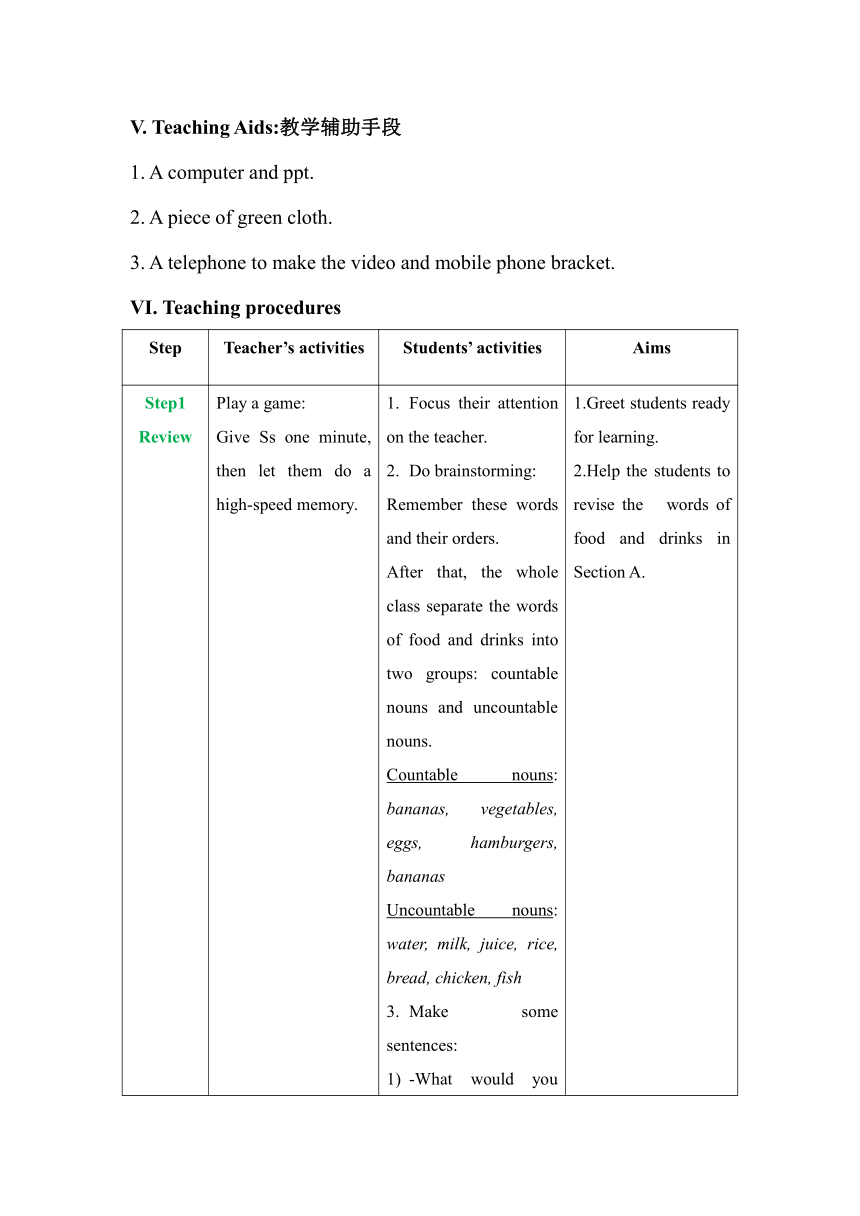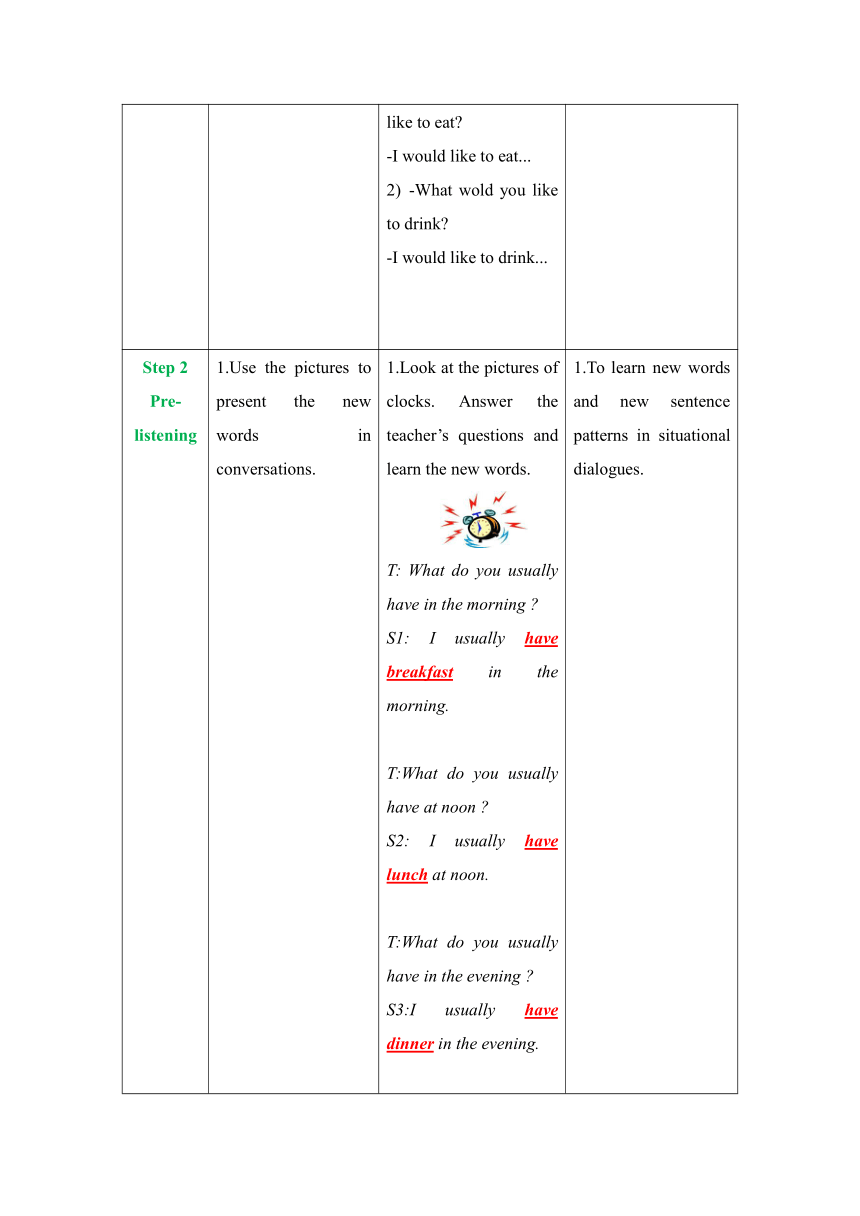Unit 3 Topic 3 What would you like to drink?教学设计(表格式)
文档属性
| 名称 | Unit 3 Topic 3 What would you like to drink?教学设计(表格式) |  | |
| 格式 | docx | ||
| 文件大小 | 32.1KB | ||
| 资源类型 | 教案 | ||
| 版本资源 | 仁爱科普版 | ||
| 科目 | 英语 | ||
| 更新时间 | 2023-09-29 11:07:39 | ||
图片预览




文档简介
七年级上Unit3 Topic3 Section B
英语教学设计-语言技能
课 题: Unit3 Getting Together
Topic3 Section B What would you like to drink
Unit 3 Getting Together
Topic 3 Section B What would you like to drink
I. Teaching aims教学目标
1. To learn some new words, phrases and sentences.
2.To communicate eating habits for three meals a day in situational dialog.
3.To master the usage of “for+breakfast/lunch/dinner” according to some activities.
4.To describe others’ eating habits.
II. Teaching Key Points教学重点
To be proficient in using expressions to discuss daily meals and order food in situational conversations.
III. Teaching Difficult Points教学难点
To present the eating habits of family members in a third-person manner in conjunction with classroom surveys.
IV. Teaching Methods教学方法
1.Situational teaching method to make students interested in what they will learn.(情景教学法)
2. Heuristic teaching method to stimulate students' thinking and show their views. (启发教学法)
V. Teaching Aids:教学辅助手段
1. A computer and ppt.
2. A piece of green cloth.
3. A telephone to make the video and mobile phone bracket.
VI. Teaching procedures
Step Teacher’s activities Students’ activities Aims
Step1 Review Play a game: Give Ss one minute, then let them do a high-speed memory. Focus their attention on the teacher. Do brainstorming: Remember these words and their orders. After that, the whole class separate the words of food and drinks into two groups: countable nouns and uncountable nouns. Countable nouns: bananas, vegetables, eggs, hamburgers, bananas Uncountable nouns: water, milk, juice, rice, bread, chicken, fish Make some sentences: -What would you like to eat -I would like to eat... -What wold you like to drink -I would like to drink... 1.Greet students ready for learning. 2.Help the students to revise the words of food and drinks in Section A.
Step 2 Pre- listening 1.Use the pictures to present the new words in conversations. 2.Let Ss make some sentences with “have...for breakfast/ lunch/dinner” 1.Look at the pictures of clocks. Answer the teacher’s questions and learn the new words. T: What do you usually have in the morning S1: I usually have breakfast in the morning. T:What do you usually have at noon S2: I usually have lunch at noon. T:What do you usually have in the evening S3:I usually have dinner in the evening. 2.To practice the sentences“have...for breakfast/ lunch/dinner” T:What do you usually have for breakfast S1: I usually have milk and bread for breakfast. T:What do you usually have for lunch S2: I usually have fish, chicken and rice for lunch. T:What do you usually have for dinner S2: I usually have juice and vegetables for dinner. 1.To learn new words and new sentence patterns in situational dialogues. To practice the usage of “ have...for breakfast/ lunch/ dinner ”
Step 3 While- listening 1.Make sure the students use “does” and “has” correctly. 2.Ask Ss to read 1a and fill in the blanks. Ask and answer questions according to 1b, talking about Michael’s eating habits. A: What does Michael usually have for breakfast B: He usually has milk and bread for breakfast. A:What does he usually have for lunch B:He usually has chicken and rice for lunch. A:What does he usually have for dinner B:He usually has jiaozi. It’s his favorite food. He likes Chinese food very much. 2. Do 1c. Read 1a again and fill in the blanks. Then report it to the class. 1.To use “does” and “has” correctly. 2.To check the answers.
Step 4 Practice Give Ss some time to do exercises. Ss choose the best answers according to the language points. To train the ability of solving problems.
Step 5 Pro- duction Do a survey about what your family members usually have for breakfast, lunch and dinner. Fill in the form and report it to the class next day; FMBBLD
Ss survey their family members about what they usually have for breakfast, lunch and dinner. A: Hello! What do you usually have for breakfast B: I usually have... A: What about lunch B: I usually have... A: And dinner B: I usually have... Then fill in the form in 2. ABCDBreakfastLunchDinner
Then make a short report. This is my mom. She usually has ... for breakfast. And for lunch, she usually has ... for lunch. What’s more, she usually has ... for dinner. This is my brother... They like their meals very much. To help the students revise and consolidate the expressions about three meals in this section. Encourage the students to speak English loudly and bravely.
Step 6 Summary Ask Ss what they have learned today. 1.Go on learning countable nouns: hamburgers、vegetables. 2.uncountable nouns: milk、juice、bread 、water 、chicken. 3.Useful expressions: 1)What do you usually have for breakfast/lunch/dinner -I usually have ... for breakfast. 2)Would you like something to drink To make a summary about today’s grammar.
Step 7 Assign Homework 1.Write a short passage. 2.Remember words&expressions. 3.Preview Section C Finish homework carefully. To consolidate the language points.
Save food and refuse to waste !
英语教学设计-语言技能
课 题: Unit3 Getting Together
Topic3 Section B What would you like to drink
Unit 3 Getting Together
Topic 3 Section B What would you like to drink
I. Teaching aims教学目标
1. To learn some new words, phrases and sentences.
2.To communicate eating habits for three meals a day in situational dialog.
3.To master the usage of “for+breakfast/lunch/dinner” according to some activities.
4.To describe others’ eating habits.
II. Teaching Key Points教学重点
To be proficient in using expressions to discuss daily meals and order food in situational conversations.
III. Teaching Difficult Points教学难点
To present the eating habits of family members in a third-person manner in conjunction with classroom surveys.
IV. Teaching Methods教学方法
1.Situational teaching method to make students interested in what they will learn.(情景教学法)
2. Heuristic teaching method to stimulate students' thinking and show their views. (启发教学法)
V. Teaching Aids:教学辅助手段
1. A computer and ppt.
2. A piece of green cloth.
3. A telephone to make the video and mobile phone bracket.
VI. Teaching procedures
Step Teacher’s activities Students’ activities Aims
Step1 Review Play a game: Give Ss one minute, then let them do a high-speed memory. Focus their attention on the teacher. Do brainstorming: Remember these words and their orders. After that, the whole class separate the words of food and drinks into two groups: countable nouns and uncountable nouns. Countable nouns: bananas, vegetables, eggs, hamburgers, bananas Uncountable nouns: water, milk, juice, rice, bread, chicken, fish Make some sentences: -What would you like to eat -I would like to eat... -What wold you like to drink -I would like to drink... 1.Greet students ready for learning. 2.Help the students to revise the words of food and drinks in Section A.
Step 2 Pre- listening 1.Use the pictures to present the new words in conversations. 2.Let Ss make some sentences with “have...for breakfast/ lunch/dinner” 1.Look at the pictures of clocks. Answer the teacher’s questions and learn the new words. T: What do you usually have in the morning S1: I usually have breakfast in the morning. T:What do you usually have at noon S2: I usually have lunch at noon. T:What do you usually have in the evening S3:I usually have dinner in the evening. 2.To practice the sentences“have...for breakfast/ lunch/dinner” T:What do you usually have for breakfast S1: I usually have milk and bread for breakfast. T:What do you usually have for lunch S2: I usually have fish, chicken and rice for lunch. T:What do you usually have for dinner S2: I usually have juice and vegetables for dinner. 1.To learn new words and new sentence patterns in situational dialogues. To practice the usage of “ have...for breakfast/ lunch/ dinner ”
Step 3 While- listening 1.Make sure the students use “does” and “has” correctly. 2.Ask Ss to read 1a and fill in the blanks. Ask and answer questions according to 1b, talking about Michael’s eating habits. A: What does Michael usually have for breakfast B: He usually has milk and bread for breakfast. A:What does he usually have for lunch B:He usually has chicken and rice for lunch. A:What does he usually have for dinner B:He usually has jiaozi. It’s his favorite food. He likes Chinese food very much. 2. Do 1c. Read 1a again and fill in the blanks. Then report it to the class. 1.To use “does” and “has” correctly. 2.To check the answers.
Step 4 Practice Give Ss some time to do exercises. Ss choose the best answers according to the language points. To train the ability of solving problems.
Step 5 Pro- duction Do a survey about what your family members usually have for breakfast, lunch and dinner. Fill in the form and report it to the class next day; FMBBLD
Ss survey their family members about what they usually have for breakfast, lunch and dinner. A: Hello! What do you usually have for breakfast B: I usually have... A: What about lunch B: I usually have... A: And dinner B: I usually have... Then fill in the form in 2. ABCDBreakfastLunchDinner
Then make a short report. This is my mom. She usually has ... for breakfast. And for lunch, she usually has ... for lunch. What’s more, she usually has ... for dinner. This is my brother... They like their meals very much. To help the students revise and consolidate the expressions about three meals in this section. Encourage the students to speak English loudly and bravely.
Step 6 Summary Ask Ss what they have learned today. 1.Go on learning countable nouns: hamburgers、vegetables. 2.uncountable nouns: milk、juice、bread 、water 、chicken. 3.Useful expressions: 1)What do you usually have for breakfast/lunch/dinner -I usually have ... for breakfast. 2)Would you like something to drink To make a summary about today’s grammar.
Step 7 Assign Homework 1.Write a short passage. 2.Remember words&expressions. 3.Preview Section C Finish homework carefully. To consolidate the language points.
Save food and refuse to waste !
同课章节目录
- Unit 1 Making new friends
- Topic 1 Welcome to China!
- Topic 2 Where are you from?
- Topic 3 How old are you?
- Unit 2 Looking different
- Topic 1 I have a small nose
- Topic 2 What does she look like?
- Topic 3 Whose jacket is this?
- Unit 3 Getting togethe
- Topic 1 Does he speak Chinese?
- Topic 2 What do your parents do?
- Topic 3 What would you like to drink?
- Unit 4 Having fun
- Topic 1 What can I do for you?
- Topic 2 Would you like to cook with us?
- Topic 3 What time is it now?
